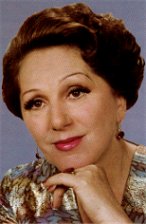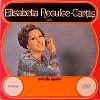
Elisabeta Neculce-Cartis
Liebestod Rec.:
Feb.1979 Dir. Neglia, Tomasso Benintende (Orchestra Siimfonica RTV) CD: Electrecord EDC 255
Mar.1979 Dir. Elenescu, Emanuel (Orchestra Sinfonica a Radioteleviziunii) LP: Electrecord STM - ECE 01555
Neculce-Cartis, Elisabeta * 25.01.1925 Bukarest, † 04.12.1998 (?); born in Bucharest, Elisabeta Necuke-Cartis spent her childhood and received her instruction at the high school in Braila, a town with a musical tradition which inscribes the names of great Romanian opera singers as Hariclea Darclee, George Niculescu-Basu, Petre Stefanescu-Goanga and which, undoubtedly, influenced the future artist's formation. She entered the Conservatoire ( Academy of Music ) in Bucharest and studied the canto at Prof. Livia Vatianu-Vrabiescu's class; other artistic personalities who guided her are the composers Dimitrie Cuclin, Vasile Popovici, loan Chirescu , the conductor Umberto Pessione , the baritone Mihail Vulpescu . After graduating the Conservatoire she doesn't consider that her studies are finished, only then she studies thoroughly the great repertoire and the secrets of the variety of styles for approaching the world and national vocal creations. Her first lieder recital was on the 18th of January 1955 in the Romanian Atheneum's studio. Then she performs hundreds of the vocal chamber lyric's jewels and becomes - because, at the same time, she is the soloist of vocal-symphonic programmes - one of the most successful concert singer of the Romanian musical life. She performs Wagner's Wesendonck Lieder, the last Four Songs by Richard Strauss, the soloistic part in Mozart's Mass in C minor and in the 9-th Symphony by Beethoven: she sings in a concert version the monodrama Erwartung by Arnold Schoenberg or excerpts from Alban Berg's Wozzeck; these performances are memorable moments for the musical experience of those ones who had the privilege to listen to. She was ever saying that her great passion is the concert music: she approached it because of her musical preferences, her excellent aesthetical education, a certain distinguished sobriety - qualities that define her interpreter profile. She was quick for finding the way to approach any new musical text, for finding the fundamental strong lines of any score her indefatigable enthusiasm meets; she continually promotes the contemporary compositions: Elisabeta Neculce-Cartis becomes one of the most important sustainer, supporter of the Romanian vocal music. The musical critique underlined her impressive achievements in this domain. The Composers Union brought her in written form its appreciation for the important services she rendered to the national creation.
Elisabeta Neculce-Cartis was appointed as soloist of the Romanian Opera in Bucharest on the 1st of January 1959. On the first lyric stage of Romania , the singer approached especially that repertoire her peculiar vocal qualities, as well as her specific cultural education, were serving the best. Her debut was on the 20th of June 1959 with the role Alice Ford in Verdi's Falstaff; then the Countess in Nozze di Figaro, Donna Elvira in Don Giovanni and Fiordiligi in Cosi fan tutte by Mozart, Eva in Die Meistersinger von Nürnberg and Elsa in Lohengrin by Wagner, the Marshal in Richard Strauss Rosenkavalier and Eurydice in Orpheus by Gluck. In 1964 when the Doru Popovici's opera ,,Prometheus" had its premiere, all the critics remark the most achieved character in the performance: the nymph Eromeni, created by Elisabeta Neculce-Cartis. Without any hierarchical enumeration, we must not forget that the artist had outstanding creations in the title role of Puccini's Madama Butterfly, in that one of Marguerite in Faust by Gounod or in Albert Herring by Britten where she created a composition complex role, overcoming with naturalness the difficulty of several complicated melodic outlines. We can also assert that she was outstanding for revealing the nobleness of the musical lines in the most sublime masterpieces of the lyrical art, with an obvious preference for the german operas; she was fore-doomed to by the peculiar manner of the phrasing, the manner to guide her voice, by her voice colour. In spite of all these, she was not an unilateral artist concerning the styles; the proof, the achieved versions of the Letters' Aria in Werther by Massenet a.o. From Gluck to Berg, from Mozart to Wagner, from Puccini to Massenet - that is the wide artistic scale of the singer's possibilities.
Text from CD booklet ALFRED HOFFMAN ( English version by Nicoleta Sonea)
|
as Elsa
|
Butterfly, Tosca, Eva and others
|
Portrait
|
LP Cover
|
||||



